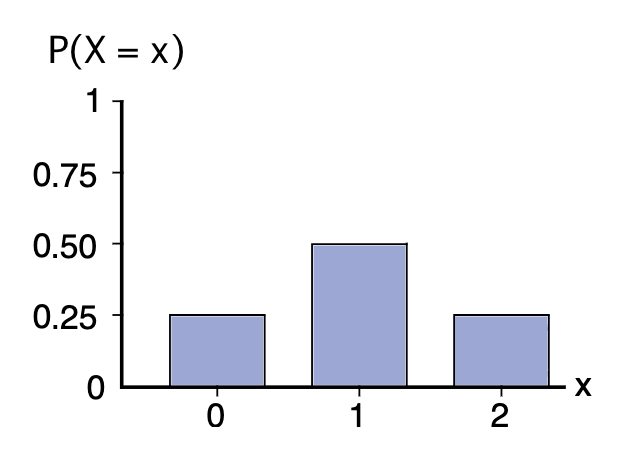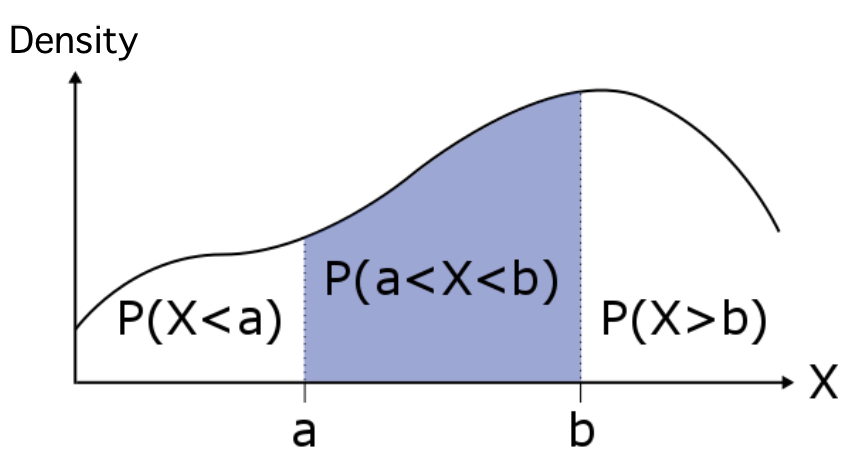Chapter 4. Probability Distributions: Random Variables
 Probability Distributions
Probability Distributions
Probability Distribution
Definition
A probability distribution is a function that links each outcome of a random experiment to the probability of its occurrence.
Notation
\[f(x)\]
#\phantom{0}#
Probability Mass Function
The probability distribution of a discrete random variable is called the probability mass function and gives the probability that #X# equals #x#, for each #x# within the range of #X#:
\[f(x)=\mathbb{P}(X=x)\]
The cumulative distribution function of a discrete random variable gives the probability that #X# is less than or equal to #x#:
\[F(x)=\mathbb{P}(X\leq x)\]
Probability distributions of discrete random variables are most commonly reported as either a function, table, or bar chart.
Consider the random experiment of flipping a balanced coin twice and observing which side is showing when it lands.
Let #X# denote the number of Heads we observe.
Then the probability mass function of #X# is:
| #x# | #0# | #1# | #2# |
| #\mathbb{P}(X=x)# | #0.25# | #0.5# | #0.25# |

And the cumulative distribution function of #X# is:
| #x# | #0# | #1# | #2# |
| #\mathbb{P}(X\leq x)# | #0.25# | #0.75# | #1# |

Cumulative Properties of Discrete Distributions
For any discrete probability distribution, the following properties regarding its cumulative probabilities hold:
- #\mathbb{P}(X \leq x) = \mathbb{P}(X=0) +\mathbb{P}(X=1) + \ldots + \mathbb{P}(X=x)#
- #\mathbb{P}(X \lt x) = \mathbb{P}(X \leq x-1)#
- #\mathbb{P}(X \gt x) = 1 - \mathbb{P}(X \leq x)#
- #\mathbb{P}(X \geq x) = 1 - \mathbb{P}(X \leq x-1)#
Additionally, for any #2# values #a# and #b# in the range of #X# (with #a\lt b#):
- #\mathbb{P}(a \leq X \leq b) = \mathbb{P}(X \leq b) - \mathbb{P}(X \leq a - 1)#
- #\mathbb{P}(a \leq X \lt b) = \mathbb{P}(X \leq b - 1) - \mathbb{P}(X \leq a - 1)#
- #\mathbb{P}(a \lt X \leq b) = \mathbb{P}(X \leq b) - \mathbb{P}(X \leq a)#
- #\mathbb{P}(a \lt X \lt b) = \mathbb{P}(X \leq b - 1) - \mathbb{P}(X \leq a)#
#\phantom{0}#
Probability Density Function
The probability distribution of a continuous random variable is called the probability density function.
It is important to note that, contrary to discrete random variables, we can never calculate the probability that a continuous random variable will be exactly equal to some value. This is because continuous random variables can take on an infinite number of possible values in any given interval, which makes the probability that we find any specific value practically zero.
Instead, we can only calculate the probability that a continuous random variable falls within some interval of values. The probability that a random variable #X# lies between #a# and #b# is given by the area under the curve from #a# to #b#.

As is the case with discrete random variables, the cumulative distribution function of a continuous random variable gives the probability that #X# is less than or equal to #x#:
\[F(x)=\mathbb{P}(X\leq x)\]
Important Properties of Continuous Distribution
For any continuous probability distribution, the following properties always hold:
- #\mathbb{P}(X=k)=0#
- #\mathbb{P}(X\leq k)=\mathbb{P}(X\lt k) =1 - \mathbb{P}(X \geq k)#
- #\mathbb{P}(X\geq k)=\mathbb{P}(X\gt k)= 1 - \mathbb{P}(X \leq k)#
Additionally, for any #2# numbers #j# and #k# (with #j\lt k#), the following properties hold:
-
#\mathbb{P}(j\lt X\lt k)=\mathbb{P}(j\leq X \lt k)=\mathbb{P}(j \lt X\leq k)=\mathbb{P}(j\leq X\leq k)#
- #\mathbb{P}(k\gt X \gt j)=\mathbb{P}(k\geq X \gt j)=\mathbb{P}(k\gt X\geq j)=\mathbb{P}(k \geq X\geq j)#
- #\mathbb{P}(j \leq X \leq k) = \mathbb{P}(X \leq k) - \mathbb{P}(X \leq j)#

Or visit omptest.org if jou are taking an OMPT exam.



